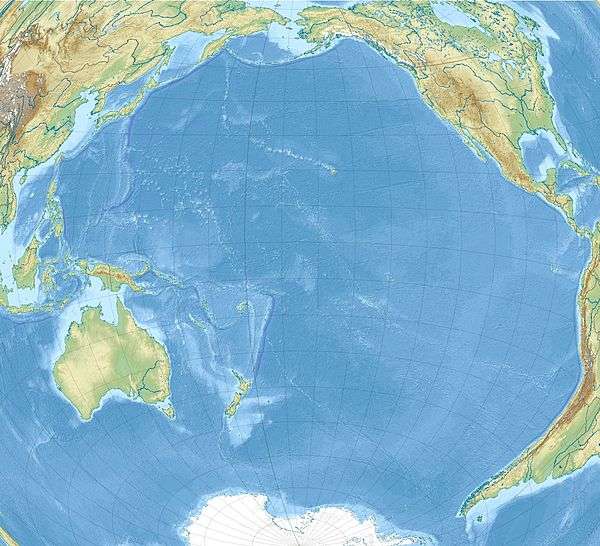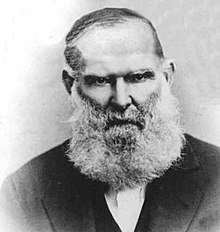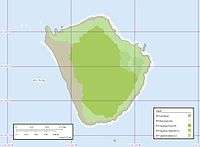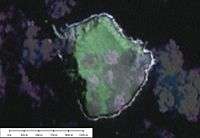ʻAta
ʻAta is a depopulated island in the far southern end of the Tonga archipelago, situated approximately 160 kilometres (99 mi) south-southwest of Tongatapu. After almost half its population was kidnapped in 1863 as slave labour, the King of Tonga moved the remaining inhabitants to ʻEua. It is also known as Pylstaart island.
Nickname:
| |
|---|---|
 ʻAta  ʻAta | |
| Geography | |
| Location | Pacific Ocean |
| Coordinates | 22°20′30″S 176°12′30″W |
| Area | 184 ha (450 acres)[1] |
| Administration | |
Tonga | |
| Demographics | |
| Population | 0 (2020) |
It is distinct from ʻAtā, an uninhabited, low coral island in the string of small atolls along the Piha passage along the north side of Tongatapu. An unrelated traditional chiefly title from Kolovai is "Ata". Although superficially spelled in similar ways, ʻAta means reflection in Tongan; Ata means dawn and is the title of a chief; and ʻAtā means more room or expanding.[2]:279
Myths
Although ʻAta must have been known to Tongans from times immemorial, as it features in old myths, it may have been confused with ʻAtā, and it is alleged not to have been remembered until the Tongans were told about it by the Europeans.[3]:17
According to Tongan myths it was, together with ʻEua, the first island hauled up by the Maui brothers from the bottom of the sea. It originally had seven hills, but Maui stamped on the highest mountain until it was flattened into its surrounding valleys, and he did likewise with the next mountains. By the time only three hills were left, he was weary and left. With the following islands he hauled up, starting with Tongatapu, he was more careful to keep them flat.[4]:144–145 The deity Laufakanaʻa was the first ruler of ʻAta.
History
Archaeologist Atholl Anderson spent 18 days exploring the abandoned village of Kolomaile in 1977,[5] which is accessible via a steep trail from the island's cobbled northern beach. Although it had been abandoned for over a century, remnants of stone walls and other evidence of human inhabitants were still visible; radiocarbon dating led Anderson to conclude that human settlement on ʻAta dated back to the 1500s or 1600s. Another archaeological survey was conducted in August 2001; fragments of pottery found during the later survey were of a type that had ceased manufacture in Tonga by 400 BC, meaning the settlement on ʻAta was considerably older than previously thought.[6]
According to oral tradition, the diviner Hama discovered ʻAta, but the first Tongans to live there were Motuʻapuaka and Tapuʻosi, who had eloped there to escape the wrath of Tapuʻosi's father, the Tuʻi Tonga Fakanaʻanaʻa;[7] when they arrived in the early 1700s, the aboriginal inhabitants played a rough game which frightened Tapuʻosi, and Motuʻapuaka drove them into a cave, then suffocated them by building a great fire at its mouth. The two lovers were presumably accompanied by attendants, befitting their high status.[2]:279–280 They and their descendants were joined by other exiles throughout the 1700s.
The first European to discover ʻAta was Abel Tasman on 19 January 1643. Because of the many tropic birds he saw near the island, he gave it the name of Pylstaert Eylant or in modern Dutch Pijlstaart, meaning arrowtail, an apt description for, and in that time the name of the tropicbird.[8] Adverse winds prohibited him from coming closer and no natives coming to him in their canoes were seen either. From his position looking towards the northeast the shape of the island resembled to him the breasts of a woman.
The island was visited by Captain James Cook during his second voyage on October 7, 1773,[8] and its coordinates were corrected by Lapérouse, who referred to the island as île Plistard.
Because of its remote location from the main islands of Tonga, ʻAta was largely self-governed; the Official Report on Central Polynesia by Charles St Julian stated its population was 150 in 1857.[8] It is one of the three islands in Tonga to have been affected by the Peruvian slave trade of 1862 to 1864; of the three, it suffered the most.
Slavers and evacuation
— Seaman John Bryan of the Grecian, Southland Times, 14 Dec 1863;[9] quoted in Slavers in Paradise (1981)[10]:83
In 1862, the Peruvian government had decided to invite indentured labourers to collect guano on Peru's Chincha Islands. A fleet of ships spread out over the Pacific, ostensibly to find willing migrants, but they quickly switched to plain kidnapping tactics instead. In June 1863 about 350 people lived on ʻAta in a village called Kolomaile (of which remnants were still visible a century later). Captain Thomas James McGrath of the whaler Grecian, having decided that slave trading was more profitable than whaling,[10]:83 [11] came along and invited the islanders on board for trading. But once almost half of the population was on board, doors and rooms were locked, and the ship sailed away. 144 people never returned.[12]
In 1929, anthropologist Edward Winslow Gifford interviewed two ex-Kolomaileans who were schoolchildren when the Grecian took its slaves; they said that "(Paul) Vehi, (Mayor of ʻAta) went aboard and presumably arranged the kidnapping. When he was returned ashore, he made a proclamation that each family was to send a good-looking man aboard with provisions to sell. There was to be no selling on shore, and furthermore the selling on the ships was to take place below decks. Once the Ata people were aboard they were sent to various rooms to select the goods they wanted in exchange. After entering the rooms the doors were locked."[2]:283 [10]:85

The whaler-turned-slaver Grecian next tried to kidnap more slaves from the Lau Islands, but was not successful there.[10]:86 At Niuafouʻou, the second island in Tonga to be affected, Grecian was able to kidnap only 30 people.[10]:86 [11] ʻUiha was to be the third, but there the islanders had actually been able to reverse roles and ambushed the slaver Margarita instead.[10]:87
Grecian never made it to Peru. Probably near Puka-Puka in the Tuamotus it met another slaver, the General Prim, which had left Callao in March. Because Grecian never obtained a labour licence from Peru, General Prim was more than willing to take the 174 Tongans back to port,[10]:87 where it arrived on 19 July.[11][13]:145 Meanwhile, however, the Peruvian government, under pressure from foreign powers and also shocked that its labour plan had turned into a slave trade, had already cancelled all labour importation licenses on 28 April. General Prim and other ships were not allowed to land their captured South Pacific slaves on Peruvian soil, but instead the Peruvian government chartered ships to take them home.
By the time the Adelante, chartered to return the Tongans, finally left on 2 October 1863, many had died or were dying from contagious diseases. In addition, Captain Escurra of the Adelante, which had been one of the most successful slavers before the licenses were revoked, had no intention to take them home after being paid $30 per head. Instead, he marooned them on uninhabited Cocos Island, well off the route to Tahiti, claiming the 426 kanakas were affected with smallpox, endangering his crew. 200 survivors were left when the whaler Active passed along and found them on 21 October. Finally, in November, the Peruvian warship Tumbes came to save the survivors, who had dwindled to just 38. They were brought to Paita, where they apparently were absorbed in the local population.[11]
Meanwhile, in Tonga, King George Tupou I, having heard of the kidnappings, sent three schooners to ʻAta to evacuate and to resettle the remaining population of Kolomaile (about 200 people) to ʻEua, where they would be safe against future attacks.[12] Until modern times, the Vehi family were wrongfully dogged by rumours they had sold the villagers into slavery.[11][12] McGrath was arrested in Bluff, New Zealand for tax evasion at the end of November 1863,[11] and the owner of the Grecian laid additional charges that McGrath had disappeared with the ship after being commissioned in 1861 for a whaling expedition.[14]
Shipwrecked
From June of 1965 to September 11, 1966 six Tongan youths, Sione Fataua (17, the eldest), "Stephen" Tevita Fatai Latu (17), "David" Tevita Fifita Siolaʻa (15, the youngest), Kolo Fekitoa (17), "Mano" Sione Filipe Totau (16), and Luke Veikoso (16, later a boxing champion),[15] all natives of Haʻafeva island, were shipwrecked on ʻAta after running away from their strict Catholic boarding school, St. Andrew's College,[16] in Nukuʻalofa on Tongatapu.[17] They had stolen a small 24-foot (7.3 m) boat on short notice and with little preparation;[18] David, the youngest, later joked the other boys had brought him along because he was the only one who knew how to sail.[16] After they anchored for the night (approximately 5 miles (10 km) north of Tongatapu) and an evening of fishing, they fell asleep; during the night a storm broke their anchor rope. The boat's sail and rudder were destroyed quickly by the wild winds.[18] Over the next eight days, they drifted a meandering course almost 320 km (200 mi) long bearing generally southwest, bailing water from their disintegrating boat until they sighted ʻAta; at that point, they abandoned their ship and swam to shore over the next 36 hours, using planks salvaged from the wreck.[17]
Mano was the first to reach land; weak from hunger and dehydration, he could not stand but called out that he had safely reached shore, and the rest followed him.[19] The boys rested after their escape for approximately three months in a small cave they dug by hand from the sea cliff, hunting sea birds for meat, blood, and eggs. Initially desperate for food and water, they found their situation improved when they discovered the ruins of the village of Kolomaile in the island's volcanic crater, following a two-day climb.[20] They revived the remnants of this 19th century habitation, surviving on feral chickens, wild taro, and banana; they captured rainwater for drinking in hollowed-out tree trunks. The boys divided up the labour, teaming up in pairs to work garden, kitchen, and guard duty.[18] The two eldest served as leaders: one spiritual, the other practical; although the boys occasionally argued, they agreed they would always reconcile after spending four hours apart.[16][21] Stephen (who would go on to become an engineer) managed to start a fire using two sticks; the boys kept the fire burning continuously for more than a year while marooned.[16]
At night, they sang and played a makeshift guitar (built by Kolo from salvaged scrap wood, wire, and coconuts)[18] to keep their spirits up, composing five songs during their exile. Once, they attempted to sail away on a raft they made from logs, but it broke up approximately 1 mile (1.6 km) offshore, and they were forced to return.[17] The breakup of their raft was fortunate in retrospect, as the boys believed they were in Samoa and had started sailing south into the open ocean.[16]
Although they had lit signal fires each time a ship passed, four failed to sight the boys.[17] On September 11, 1966 the Australian fishing boat Just David, captained by Peter Warner (son of Sir Arthur Warner),[21] approached ʻAta after Warner noticed unusual patches of burned grass on the island's cliffsides.[18] Warner, at the time still helping to run the family business, Electronics Industries, also had been moonlighting as a fisherman with a small fleet of boats based in Tasmania. Once the local waters had been played out, he asked permission to fish in Tongan waters, but was denied and was sailing near ʻAta on the return trip.[22]
— "Mano" Totau, 2020 interview with Kate Lyons, published in The Guardian[19]
After spotting the unkempt, naked boys through binoculars, Just David approached cautiously, as Warner was told that serious criminals were sometimes marooned on remote islands. When the ship was close enough, Stephen dove in and swam to the boat, telling the crew "We are six and we estimate that we have been here for fifteen months" in perfect English.[16] The boys' count turned out to be only two days off the actual date.[17] To verify their story, Warner radioed their names to Nukuʻalofa and after a 20-minute wait, was told "You found them! These boys have been given up for dead. Funerals have been held. If it's them, this is a miracle!" Upon later examination, all six boys were healthy; Stephen had broken a leg during their stay, which had since healed, and a Tongan doctor later marvelled at the perfection of its setting by the other boys.[18] Initial news reports stated they had stayed on ʻAta for 13 months.[23]
After an enormous celebration and minor legal drama on Haʻafeva, when the owner of the boat pressed charges for theft and had the boys arrested, the group was hired by Warner to crew a lobsterboat.[17][18] During the feasts celebrating the boys' return, he noticed the meals often featured copious portions of Pacific spiny lobster. The families of the castaway boys promised to teach Warner the secrets of how and where to fish for them,[24] and Warner was given a royal concession to trap the spiny lobster in Tongan waters as a reward for rescuing the group,[17][18] leading to a long friendship between Warner and King Tāufaʻāhau Tupou IV.[25]
Several documentary films have been made about the boys' ordeal. Warner learned the boys had been incarcerated when they did not show up to a party he was holding to honour them.[19] Warner then arranged with Channel 7 in Sydney to film their story; he used GB£150 from the sale of the rights to compensate the stolen boat's owner for its loss, who dropped the charges and the television crew sailed with Warner and the boys back to ʻAta to film a re-enactment of their story,[16] which was broadcast in October 1966.[26] Only one copy of the 1966 documentary, filmed on 16mm, survives today. Steve Bowman, who owns that copy, interviewed the boys in 2006 and 2007 for another documentary, but it was never released because his distributor went bankrupt.[16]
In 2015 Spanish explorer Alvaro Cerezo spent 10 days on ʻAta island with Kolo Fekitoa, one of the six teenage castaways. They both lived there all alone and survived from coconuts, fish and seabirds, exactly as the boys did back in 1965. In summer 2020, Cerezo is launching a documentary of his experience with Kolo and a book describing in detail the 15 month ordeal of the Tongan castaways.[27] The 1966 documentary, The Castaways, is available on YouTube.[20]
Kolo Fekitoa died in approximately 2017, at the age of 71. Three of the others are now living overseas: Mano (Australia), Luke (United States), Sione (United States), Tevita Siola'a (New Zealand).[28]
Current status
The descendants of the original ʻAta island dwellers still live in the southern village of Haʻatuʻa on ʻEua, of which a part has received the name Kolomaile.[12] Their wish to return to ʻAta was still alive in the mid-20th century, but it is considered unlikely to happen, as the island does not have a harbour, making shipping to it a dangerous and uneconomical adventure. Currently ʻAta, still part of the kingdom of Tonga, remains uninhabited.[12]
Geography
Most of ʻAta's land is a high plateau 60 to 100 metres (200 to 330 ft) above sea level, with steep cliffs and rocky beaches ringing the shoreline of the entire island. There are three minor peaks: two on the west side and one on the east side of the island, ranging in elevation from 180 metres (590 ft) (eastern) to 307 and 309 metres (1,007 and 1,014 ft) (western). It has a total land area of approximately 1.5 km2 (0.58 sq mi). Although it was apparently formed by volcanic action, no record of volcanic activity exists.[29] The anchorage for ʻAta is on the west side of the island.[2]:279
There was only one settlement on ʻAta, named Kolomaile, meaning "Myrtle town", near the eastern hill. There were three sections of the village; the western section was Hihifo, and the other two were Auloto and Pea.[2]:279
Ecology
Since 1863, the island has not been inhabited by a residential human population. Surveys of animal populations have been conducted in 1925 (Whitney South Seas Expedition, 13–14 July)[1] and 1990 (Rinke, 5–8 April).[29]
Fauna
The only mammal native to the island is Rattus exulans, the Polynesian rat. In a survey conducted in 1990, the most common seabird present was Puffinus pacificus, the wedge-tailed shearwater, with an estimated 20,000 present.[29]
Flora
The plateau of ʻAta is heavily forested with fig trees.[29]
See also
- Desert island
- List of islands
References
- "Factsheet: ʻAta Island". BirdLife International. Retrieved 9 May 2020.
- Gifford, Edward Winslow (1929). "The outlying islands: Ata island". Tongan society. Honolulu, Hawaii: Bernice P. Bishop Museum. pp. 278–282.
- Gifford, Edward Winslow (1924). "Cosmogony". Tongan myths and tales. Honolulu, Hawaii: Bernice P. Bishop Museum. pp. 14–20.
- Fison, Lorimer (1904). "The Beginning of Death". Tales from Old Fiji. London: The De La More Press. pp. 139–161.
- Anderson, Atholl (1979). "Archaeological explorations on Ata Island, Tonga, in Lau-Tonga 1977". Royal Society of New Zealand Bulletin. 17: 1–21.
- Burley, David V. (April 16, 2020). "ʻAta and its archaeology". Matangi: Tonga Online. Retrieved 9 May 2020.
- D'Arcy, Paul (2006). The People of the Sea: Environment, Identity and History in Oceania. Honolulu, Hawaiʻi: University of Hawaiʻi Press. p. 63. ISBN 978-0-8248-2959-9. Retrieved 9 May 2020.CS1 maint: location (link)
- St. Julian, Charles (1857). Official Report on Central Polynesia. His Hawaiian Majesty's Commission. p. 33. Retrieved 9 May 2020.
- "The Brig Grecian, and the slave trade in the South Seas Islands". Southland Times. III (16). 14 December 1863.
- Maude, Henry Evans (1981). "11 | Tonga: the Tale of the Hobart Whaler Grecian". Slavers in Paradise: The Peruvian Labour Trade in Polynesia, 1862-1864. Canberra: Australian National University Press. pp. 83–87. ISBN 0-7081-1607-8. Retrieved 9 May 2020. Open-access PDF
- Munro, Bruce (14 December 2016). "Sold into slavery". Otago Daily Times. Retrieved 9 May 2020.
- Hamilton, Scott (2016-12-04). "Scott Hamilton: A slave raid in the Pacific". E-Tangata - A Māori and Pasifika Sunday magazine. Retrieved 2018-04-24.
- Kirk, Robert W. (2012). "12. Vanished: Easter Island's Incredible Culture, 1722–1914". Paradise Past: The Transformation of the South Pacific, 1520-1920. Jefferson, North Carolina: McFarland & Company, Inc. pp. 138–148. ISBN 978-0-7864-6978-9. Retrieved 9 May 2020.
- Munro, Bruce (23 January 2017). "Document confirms a slaver's character". Otago Daily Times. Retrieved 9 May 2020.
- "Seven named for the National Sports Hall of Fame". Matangi: Tonga Online. December 8, 2009. Retrieved 11 May 2020.
- Bregman, Rutger (4 September 2019). "Wat er écht gebeurt als kinderen op een onbewoond eiland stranden" [What really happens when children are stranded on a deserted island]. de Correspondent (in Dutch). Retrieved 11 May 2020.
- Lavin, Dorothy (1966-10-01). "Tongan Robinson Crusoes Gaoled After 15 Months On Lonely Isle". Pacific Shipping and Cruising Yachts.
- Bregman, Rutger (2020-05-09). "The real Lord of the Flies: what happened when six boys were shipwrecked for 15 months". The Guardian. ISSN 0261-3077. Retrieved 2020-05-09.
- Lyons, Kate (May 14, 2020). "The 'real Lord of the Flies': a survivor's story of shipwreck and salvation". The Guardian. Retrieved 14 May 2020.
- The real Lord of the Flies: what happened when six boys were shipwrecked for 15 months on YouTube
- Brown, Jamie (12 December 2014). "Mates Share 50-Year Bond". Daily Mercury. Retrieved 10 May 2020.
- Rabbitts, Fran (August 9, 2014). "Adventure of a Lifetime". Tweed Daily News. Retrieved 10 May 2020.
- "Rescued after 13 months". The Canberra Times. AAP. September 14, 1966. Retrieved 13 May 2020.
- Keavney, Kay (19 June 1974). "The Dropout Who Went to Sea". The Australian Women's Weekly. Retrieved 10 May 2020.
- Rabbitts, Fran (October 20, 2016). "King's blessing inspires amazing new book". Tweed Valley Weekly. Retrieved 10 May 2020.
- "Sunday showing for Tongan castaways". The Age. Melbourne. October 6, 1966. Retrieved 12 May 2020.
- Cerezo, Alvaro (2020-04-10). "The Six Tongan Survivors. The Teenager Castaway Boys. The Documentary". Youtube. Retrieved 2020-04-10.
- Gee, Eleanor; Folau, Linny (May 14, 2020). "Kolo Fekitoa, one of six castaways on Ata Island remembered". Matangi: Tonga Online. Retrieved 14 May 2020.
- Rinke, Dieter R. (1991). "Birds of ʻAta and Late, and additional notes on the avifauna of Niuafoʻou, Kingdom of Tonga" (PDF). Notornis. 38: 131–151. Retrieved 9 May 2020.
Further reading
- Fison, Lorimer (1904). "The Beginning of Death". Tales from Old Fiji. London: The De La More Press. pp. 139–161.
- Gifford, Edward Winslow (1924). Tongan myths and tales. Honolulu, Hawaii: Bernice P. Bishop Museum.
- Gifford, Edward Winslow (1929). "The outlying islands: Ata island". Tongan society. Honolulu, Hawaii: Bernice P. Bishop Museum. pp. 278–282.
- Willey, Keith (1970). Naked Island and Other South Sea Tales. Sydney: Hodder and Stoughton. ISBN 0-340-12603-5.
- Maude, Henry Evans (1981). "11 | Tonga: the Tale of the Hobart Whaler Grecian". Slavers in Paradise: The Peruvian Labour Trade in Polynesia, 1862-1864. Canberra: Australian National University Press. pp. 83–87. ISBN 0-7081-1607-8. Open-access PDF
- Hamilton, Scott (2016). The Stolen Island: Searching for ʻAta. Wellington, New Zealand: Bridget Williams Books. ISBN 9780947518127.
- Bregman, Rutger (2020). Humankind: A Hopeful History. Translated by Elizabeth Manton; Erica Moore. Little, Brown and Company. ISBN 978-0316418539. Tells the 1966 story; excerpt
External links
- rona.h (November 18, 2013). "20131118 'Ata, Tonga". flickr.
- "Tongan seaman aboard the fishing trawler Ata. Skipper Peter Warner with (left to right) Stephen, Kolo[,] Luke, David, John and Mano". Getty Images. March 1, 1968. Alternate image, same session
- Peter is 87 and FEARLESS on YouTube. Peter Warner and Mano Totau
- Brown, Jamie (2014). "Buy Photos: Peter Warner and Mano Totau". The Northern Star.
- Bregman, Rutger [@rcbregman] (May 10, 2020). "Wow. Really overwhelmed with the response to my story about the real 'Lord of the Flies.'" (Tweet) – via Twitter.
- The Six Tongan Castaways in Ata Island: OLD DOCUMENTARY FROM CHANNEL 7 on YouTube. Channel 7 Documentary (1966)

